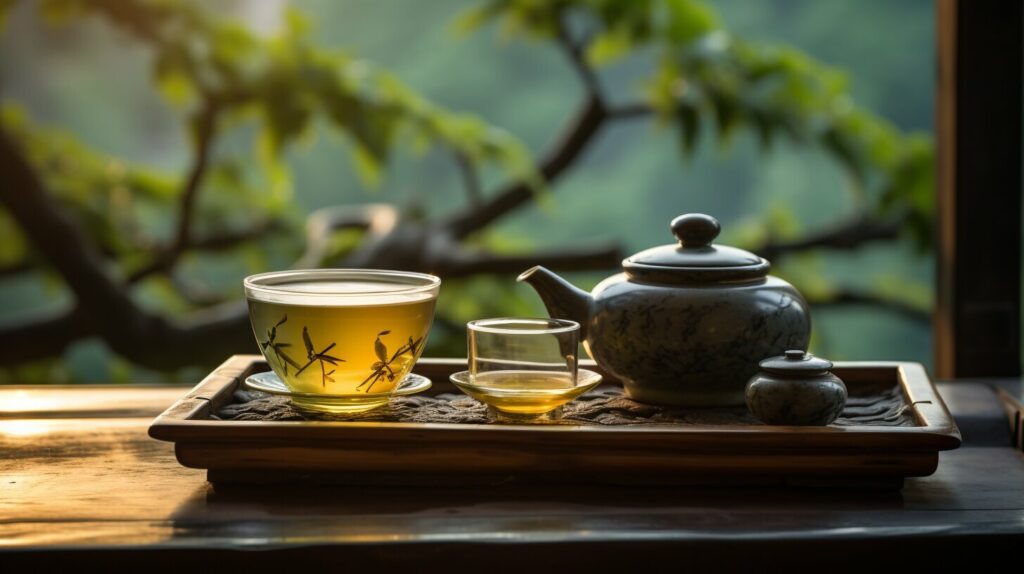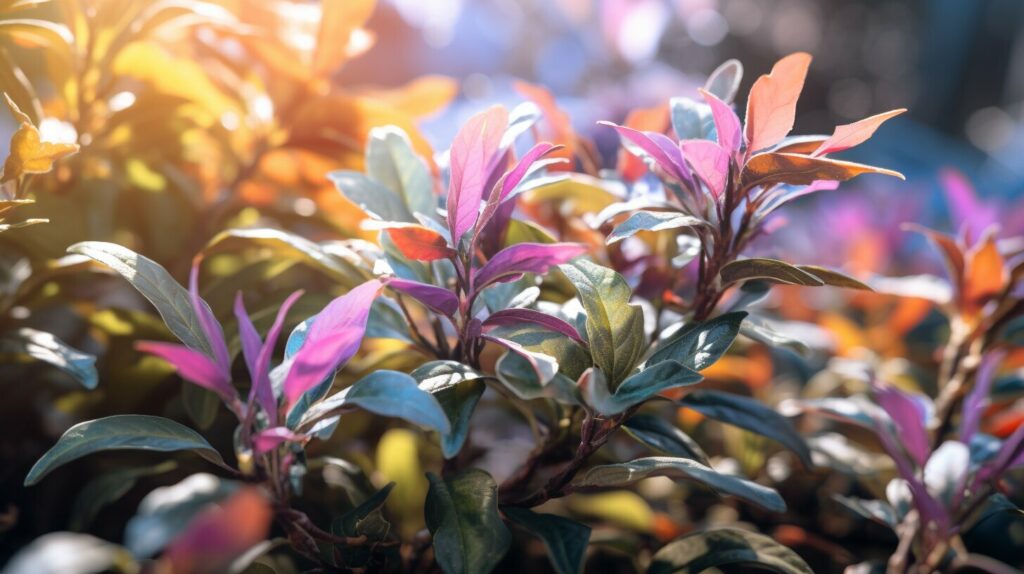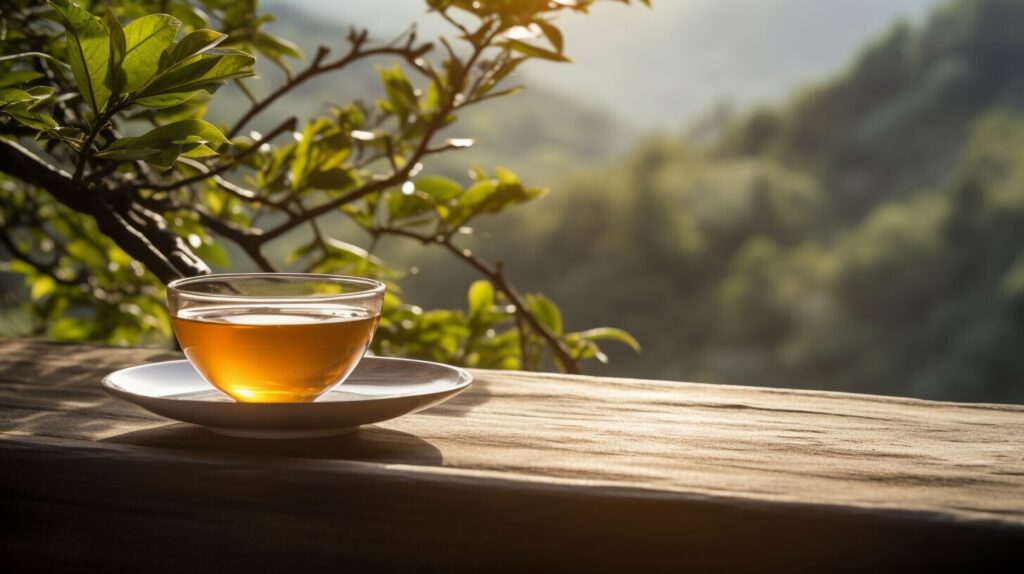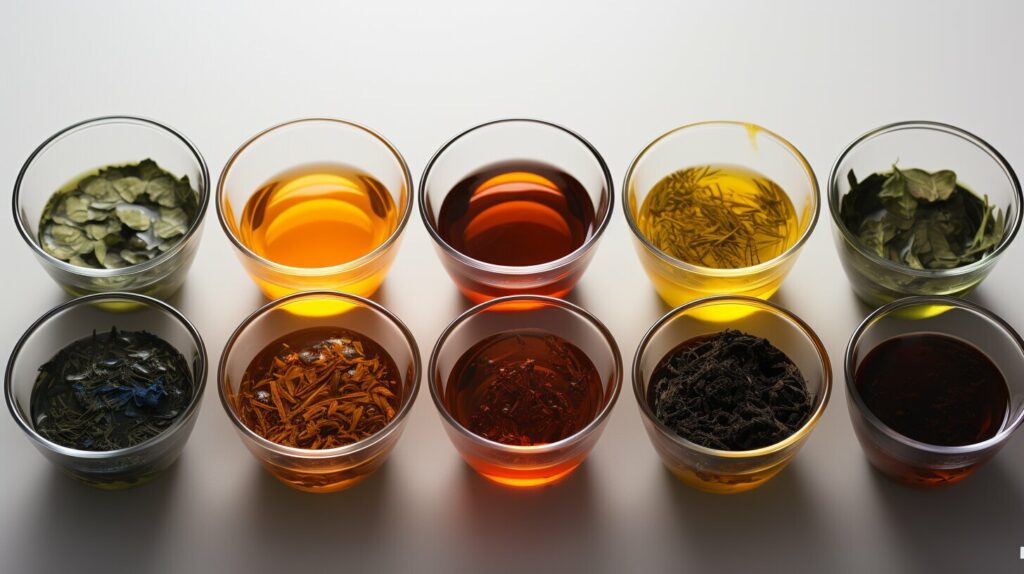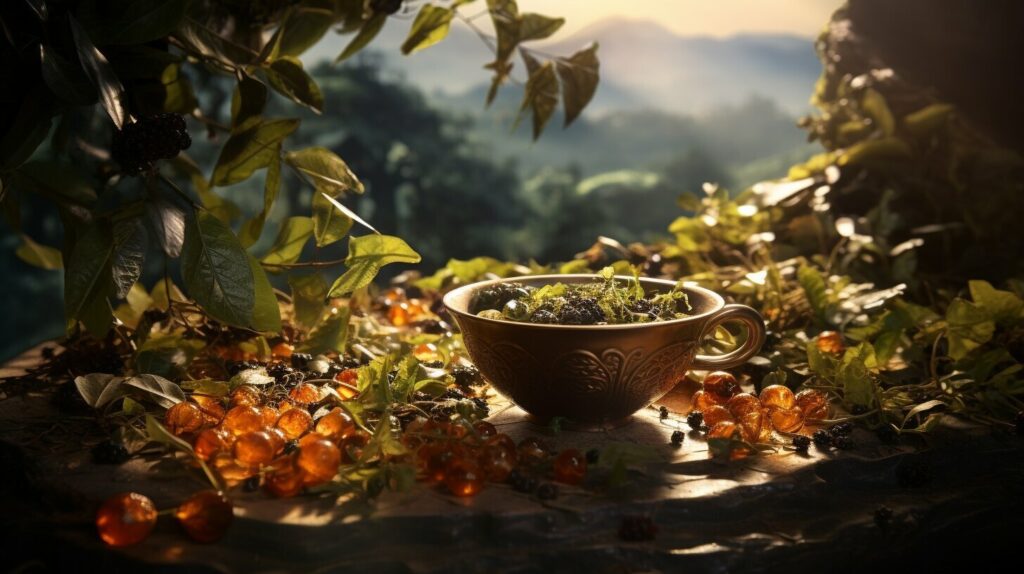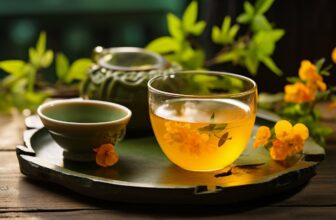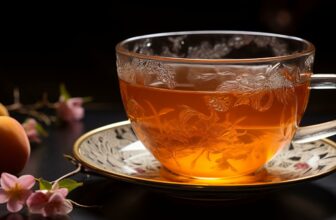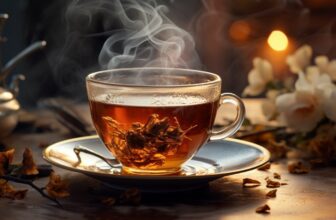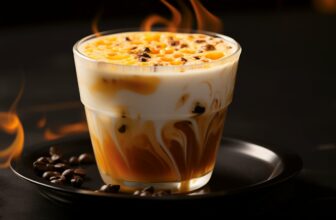
Oolong tea, made from the leaves of the Camellia Sinensis plant, offers a taste experience that falls between green tea and black tea. Its flavor profile is rich and complex, capturing the best of both worlds. Oolong tea is known for its unique craftsmanship that brings out a range of flavors in the tea leaf. It is richer than green tea but less astringent than black tea, creating a delightful balance of taste.
Key Takeaways:
- Oolong tea offers a rich and complex flavor profile.
- It falls between the taste of green tea and black tea.
- Oolong tea is crafted to bring out the best flavors in the tea leaf.
- It is richer than green tea but less astringent than black tea.
- The taste of oolong tea varies based on factors such as oxidation level, terroir, and tea cultivar.
What are the Tasting Notes of Oolong Tea?
Oolong tea offers a delightful array of tasting notes, making it a beloved choice among tea connoisseurs. The flavor profile of oolong tea is complex and diverse, encompassing a wide range of aromas and flavors. From floral notes to fruity undertones, each variety of oolong tea has its own unique characteristics that contribute to its distinct taste.
Chinese Iron Goddess Oolong, for example, exhibits a succulent sweetness with hints of floral notes emerging in later infusions. Its delicate flavor is reminiscent of ripe peaches and spring blossoms, creating a harmonious and pleasant drinking experience. On the other hand, Rare Pipachá Oolong surprises with its taste of dried fruits and honey, complemented by an elegant port wine aroma. The combination of flavors in this oolong tea creates a sophisticated and lingering finish.
“Da Hong Pao Oolong, known as the Big Red Robe, boasts a dark amber color and a deep flavor profile of nutty chocolate.”
Da Hong Pao Oolong, known as the Big Red Robe, boasts a dark amber color and a deep flavor profile of nutty chocolate. This oolong tea has a rich and robust taste, making it a favorite among those who prefer stronger flavors. The distinct characteristics of each oolong tea variety make it a beverage that can be enjoyed by those with a wide range of taste preferences.
Aroma of Oolong Tea
In addition to its diverse tasting notes, oolong tea also offers a captivating aroma. The aroma of oolong tea can vary depending on the variety and the specific crafting process. For example, Golden Lily Milk Oolong exudes a naturally sweet and creamy fragrance, reminiscent of fresh milk. This delightful aroma is a result of the tea varietal and the skillful techniques employed by the tea master.
Table: Tasting Notes of Different Oolong Teas
| Oolong Tea Variety | Tasting Notes |
|---|---|
| Chinese Iron Goddess Oolong | Succulent sweetness with floral notes |
| Rare Pipachá Oolong | Dried fruits and honey with a port wine finish |
| Da Hong Pao Oolong | Nutty chocolate flavor |
| Golden Lily Milk Oolong | Naturally sweet and creamy aroma |
As the table above highlights, oolong tea offers a diverse range of tasting notes, ensuring that there is a flavor profile to suit every palate. Whether you prefer the sweetness of floral notes or the richness of nutty chocolate, there is an oolong tea variety that will captivate your senses and provide a truly unique tea-drinking experience.
What Factors Influence the Flavor of Oolong Tea?
Oolong tea is known for its rich and complex flavors, which are influenced by several key factors. These factors play a significant role in defining the unique taste profile of each oolong tea variety. Understanding these factors can help tea enthusiasts appreciate the nuances and variations in oolong tea flavors.
Oxidation Level
The oxidation level of oolong tea leaves is one of the primary factors that influence flavor. Oolong teas can range from lightly oxidized to heavily oxidized, with varying degrees in between. Low oxidation oolong teas tend to have a greener and sweeter flavor profile, with notes of fresh grass or flowers. On the other hand, higher oxidation oolong teas have a more robust and fruity taste, reminiscent of tropical fruits or baked goods.
Terroir
The terroir, or the environmental conditions in which oolong tea is grown, also impacts its flavor. Factors such as soil pH, elevation, rainfall, and sun exposure can contribute to the unique taste characteristics of oolong tea. For example, oolong teas grown in high-altitude mountain regions may have a more delicate and floral flavor, while those grown in lower elevations might exhibit stronger and earthier notes.
Tea Cultivar and Tea Master
The choice of tea cultivar and the expertise of the tea master further contribute to the flavor complexity of oolong tea. Different tea cultivars have distinct genetic profiles, resulting in variations in flavor profiles. Additionally, the tea master’s skill in processing and crafting the tea leaves can bring out specific flavors and aromas, creating a truly unique oolong tea experience.
By considering these factors, tea enthusiasts can appreciate the artistry and complexity behind the flavors of oolong tea. Whether enjoying a lightly oxidized, floral oolong or a deeply oxidized, fruity variety, exploring the factors that influence flavor adds depth and appreciation to the oolong tea tasting experience.
| Factor | Influence on Flavor |
|---|---|
| Oxidation Level | Determines the sweetness and fruitiness of the tea. |
| Terroir | Affects the overall character and nuances of the tea. |
| Tea Cultivar | Impacts the genetic profile and specific flavor notes. |
| Tea Master | Influences the artistry and craftsmanship of the tea. |
Is Oolong Tea Flavored?
Oolong tea is renowned for its unique and complex flavors, which are derived naturally from the tea leaves and the skillful craftsmanship involved in its production. Unlike artificially flavored teas, the best loose leaf oolong teas do not require any additional flavorings. However, there are some exceptions where oolong teas are intentionally flavored to create distinct taste experiences. One such example is milk oolong, which has gained popularity for its creamy and smooth flavor.
The distinct aroma and flavor of milk oolong are created through a specialized process that involves exposing the tea leaves to a specific type of milk powder during production. This flavor infusion enhances the tea’s natural sweetness and adds a milky note to its profile. When brewed, milk oolong releases a delightful fragrance that is reminiscent of buttery cookies and fresh cream.
It’s important to note that not all oolong teas are flavored. Many oolong teas showcase their unique flavors through the natural characteristics of the tea leaves, influenced by factors such as oxidation level, terroir, and tea cultivar. These teas offer a wide range of taste profiles, from floral and fruity to nutty and roasted. Each cup of oolong tea is a journey of discovery, as the flavors evolve with each infusion.
In summary, while oolong tea can be flavored, it is not a common practice for high-quality loose leaf oolong teas. The flavors of oolong tea are primarily derived from the tea leaves themselves, making each variety a unique and captivating experience for tea enthusiasts.
| Oolong Tea Variety | Flavor Profile |
|---|---|
| Iron Goddess Oolong | Succulent sweetness with floral notes |
| Pipachá Oolong | Dried fruits and honey with a port wine finish |
| Da Hong Pao Oolong | Deep flavor of nutty chocolate |
How to Brew the Best Tasting Cup of Oolong Tea?
When brewing oolong tea, there are several key factors to consider in order to achieve the best tasting cup. The brewing method, temperature, and steeping time all play a crucial role in bringing out the unique flavors and aromas of oolong tea. Here are some best brewing practices to guide you:
- Choose the right brewing vessel: You can use a traditional Chinese gaiwan or a teapot to brew oolong tea. Both methods work well, so it’s a matter of personal preference.
- Measure the tea leaves: The recommended amount of oolong tea is about 1 to 2 teaspoons for every 8 ounces of water. Adjust the quantity based on your preference for a stronger or milder flavor.
- Control the water temperature: Oolong tea is best brewed with water that is around 185°F to 203°F (85°C to 95°C). Boiling water can scorch the leaves and result in a bitter taste, so let it cool for a few minutes before pouring it over the tea leaves.
- Steeping time: The steeping time for oolong tea can vary depending on the desired strength. Generally, a quick infusion of 1 to 2 minutes will give you a lighter, sweeter cup, while a longer infusion of 3 to 5 minutes will bring out deeper flavors. Experiment with different steeping times to find your perfect brew.
Additional Tips:
- Use high-quality water: The quality of the water you use can greatly affect the flavor of your oolong tea. Filtered or spring water is recommended for the best results.
- Multiple infusions: Oolong tea is often good for multiple infusions. Gradually increase the steeping time with each infusion to extract different layers of flavor from the tea leaves.
- Enjoy the process: Brewing oolong tea is an art form. Take the time to savor the aroma as it wafts from your teacup and appreciate the nuanced flavors that unfold with each sip.
By following these brewing techniques, you can unlock the full potential of your oolong tea and enjoy a truly exceptional cup every time.
| Tea Brewing Method | Water Temperature | Steeping Time |
|---|---|---|
| Gaiwan | 185°F to 203°F (85°C to 95°C) | 1 to 5 minutes |
| Teapot | 185°F to 203°F (85°C to 95°C) | 1 to 5 minutes |
Remember, these brewing guidelines can serve as a starting point, but feel free to adjust them based on your personal taste preferences. With a little experimentation and practice, you’ll discover the perfect brewing method that brings out the best in your oolong tea.
How does the Taste of Oolong Tea Compare to Other Teas?
Oolong tea offers a unique flavor that sets it apart from other teas. When comparing oolong tea to green tea, oolong tea is generally richer and more complex in flavor. Green tea, on the other hand, has a more delicate and grassy taste. Oolong tea strikes a balance between the lightness of green tea and the boldness of black tea, making it a satisfying choice for tea enthusiasts.
Compared to black tea, oolong tea is typically less astringent and has a smoother finish. Black tea tends to have a stronger and more robust flavor profile, while oolong tea offers a nuanced and layered taste experience. The unique crafting process of oolong tea brings out complex flavors that vary depending on factors such as oxidation level, terroir, and tea cultivar. These factors contribute to the distinctive taste of oolong tea.
Oolong tea strikes a balance between the lightness of green tea and the boldness of black tea, making it a satisfying choice for tea enthusiasts.
Oolong Tea vs. Green Tea
| Oolong Tea | Green Tea |
|---|---|
| Richer and more complex flavor | Delicate and grassy taste |
| Less astringent | Light and refreshing |
| Nuanced and layered taste experience | Subtle and clean flavor |
Oolong Tea vs. Black Tea
| Oolong Tea | Black Tea |
|---|---|
| Less astringent | Strong and robust flavor |
| Smoother finish | Bolder aftertaste |
| Complex and nuanced taste | Straightforward and bold flavor profile |
Whether you prefer the delicate notes of green tea or the boldness of black tea, oolong tea offers a unique taste experience that bridges the gap between the two. Its rich flavor, balanced astringency, and complex taste profile make it a versatile and captivating choice for tea enthusiasts.
Where Can I Buy Oolong Tea?
If you are looking to buy oolong tea, there are several options available to you. One recommended source is Rare Tea, an online retailer that offers a curated collection of oolong teas sourced from independent tea gardens around the world. Their selection includes a variety of oolong flavors and styles, ensuring that you can find the perfect tea to suit your taste preferences.
When you purchase oolong tea from Rare Tea, you can trust that you are getting high-quality loose leaf teas that have been carefully selected. They prioritize working directly with tea farmers and producers to ensure fair trade practices and sustainable sourcing. Their teas are also handpicked and expertly crafted, resulting in teas that are rich in flavor and aroma.
Ordering from Rare Tea is convenient and hassle-free. They ship globally, so you can enjoy their teas no matter where you are in the world. The teas are carefully packaged to preserve freshness and quality, and they offer secure online payment options for a smooth transaction. Whether you are a beginner or a seasoned oolong tea enthusiast, Rare Tea is a reliable source to buy oolong tea.
| Rare Tea | Shipping | Payment Options |
|---|---|---|
| Curated collection of oolong teas | Global shipping | Secure online payment |
| Direct sourcing from independent tea gardens | Carefully packaged for freshness | Convenient and hassle-free |
| Fair trade and sustainable sourcing |
Other Options
In addition to Rare Tea, there are other online tea shops and local specialty stores where you can purchase oolong tea. Online platforms such as Amazon and specialty tea retailers like Teavana offer a wide variety of oolong tea options. Local tea shops and tea houses may also carry oolong tea, allowing you to explore and support small businesses in your area.
When buying oolong tea, it’s important to read reviews and consider the reputation of the seller. Look for teas that are labeled as high-quality, loose leaf teas and avoid products that contain artificial flavorings or additives. By choosing reputable sources, you can ensure that you are getting the best oolong tea experience.
Is Oolong Tea Healthy?
Oolong tea offers not only a delightful taste but also numerous health benefits. This unique tea contains compounds that have been found in both green and black tea, such as EGCG (Epigallocatechin gallate), which is known for its antioxidant properties.
Research suggests that regular consumption of oolong tea may aid in weight loss by boosting metabolism and fat oxidation. Additionally, oolong tea has been found to improve gut health by promoting the growth of beneficial gut bacteria and reducing inflammation in the digestive system.
The compounds found in oolong tea have also shown promise in lowering cholesterol levels and reducing the risk of heart diseases. Studies have indicated that regular consumption of oolong tea may help decrease LDL cholesterol levels and improve overall cardiovascular health.
“Oolong tea contains compounds that may aid in weight loss, improve gut health, reduce inflammation, lower cholesterol levels, and reduce the risk of heart diseases.”
It’s important to note that oolong tea does contain caffeine, which can provide a natural energy boost. However, individuals with certain health conditions, such as anxiety disorders or sensitivity to caffeine, should consult with a healthcare professional before consuming large quantities of oolong tea.
To reap the health benefits of oolong tea, it is recommended to include it as part of a balanced diet and a healthy lifestyle. Enjoy a cup of oolong tea in the morning or as an afternoon pick-me-up, and savor its unique flavor while nourishing your body with its beneficial compounds.
Table: Health Benefits of Oolong Tea
| Health Benefit | Description |
|---|---|
| Weight Loss | Oolong tea may boost metabolism and fat oxidation, aiding in weight loss. |
| Gut Health | Regular consumption of oolong tea may promote the growth of beneficial gut bacteria and reduce inflammation in the digestive system. |
| Heart Health | Oolong tea has been found to lower cholesterol levels and reduce the risk of heart diseases. |
| Antioxidant Properties | Oolong tea contains antioxidants that help protect the body against free radicals and oxidative stress. |
Disclaimer: The information provided in this article is for informational purposes only and is not intended as medical advice. It is always recommended to consult with a healthcare professional before making any changes to your diet or lifestyle.
How to Brew the Best Cup of Oolong Tea?
Brewing the best cup of oolong tea requires attention to detail and an understanding of the proper brewing methods, temperature, and steeping time. Let’s explore the key steps to achieve a flavorful and satisfying cup of oolong tea.
Brewing Methods
Oolong tea can be brewed using various methods, but two common approaches are using a traditional Chinese gaiwan or a teapot. The gaiwan, a small lidded bowl, allows for multiple infusions and greater control over flavor extraction. Alternatively, a teapot can also be used, providing a convenient way to brew larger quantities.
Brewing Temperature
The temperature at which oolong tea is brewed plays a crucial role in bringing out its flavors. The ideal brewing temperature for oolong tea ranges from 185°F to 203°F (85°C to 95°C). Lower temperatures are recommended for lighter oolongs, while higher temperatures are suitable for darker oolongs. Experimenting with different temperatures can help you find your preferred flavor profile.
Steeping Time
The steeping time of oolong tea depends on personal preference and the desired strength of the brew. Generally, oolong tea is steeped for 3-5 minutes, but you can adjust the time to achieve the desired flavor intensity. For a milder cup, steep for a shorter time, and for a stronger cup, extend the steeping time. It’s important to note that oolong tea can often be steeped multiple times, gradually increasing the brewing time with each infusion.
By following these brewing methods, paying attention to the temperature and steeping time, you can experience the full range of flavors that oolong tea has to offer. Remember to experiment and explore different variations to find your perfect cup of oolong tea.
Conclusion
In conclusion, oolong tea is a fascinating and versatile beverage that offers a unique taste experience. Positioned between green tea and black tea, oolong tea provides a rich flavor profile that is neither too light nor too intense. With its complex and diverse range of flavors, oolong tea caters to the preferences of tea enthusiasts looking for something beyond the ordinary.
The taste of oolong tea is influenced by various factors, including the oxidation level, terroir, and tea cultivar. These elements combine to create a wide spectrum of flavors and aromas, making every cup of oolong tea a delightful exploration of the senses.
When brewing oolong tea, it is essential to pay attention to the brewing method, temperature, and steeping time. This ensures that the flavors are properly extracted and the true essence of the tea is captured in every sip. With a bit of patience and experimentation, one can discover their perfect cup of oolong tea.
Whether you are a tea aficionado or new to the world of oolong tea, its diverse range of tastes and aromas is sure to captivate your palate. So why not embark on a journey of flavors and indulge in the enchanting experience that oolong tea has to offer?
FAQ
What is the taste of oolong tea?
Oolong tea has a flavor profile that falls between green tea and black tea. It is rich and complex, with variations depending on factors like oxidation level, terroir, and tea cultivar.
What are the tasting notes of oolong tea?
Oolong tea has a wide range of tasting notes, with each variety offering unique flavors and aromas. Some examples include succulent sweetness with floral notes, dried fruits and honey with a port wine finish, and a deep flavor of nutty chocolate.
What factors influence the flavor of oolong tea?
The flavor of oolong tea is influenced by factors such as oxidation level, terroir (including soil pH, elevation, rainfall, and sun exposure), tea cultivar, and the expertise of the tea master.
Is oolong tea flavored?
While the best loose leaf oolong teas do not require any artificial or natural flavorings, some oolong teas, such as milk oolong, can be flavored with milk powder. However, certain oolong teas have natural aromas derived from the tea varietal and the skill of the tea master.
How to brew the best tasting cup of oolong tea?
Brewing oolong tea requires attention to the brewing method, temperature, and steeping time. Quick infusions result in a softer, sweeter cup, while longer infusions bring out more bitter notes. Using good water, proper utensils, and following recommended brewing practices will help achieve the best flavor.
How does the taste of oolong tea compare to other teas?
Oolong tea is richer and more complex in flavor compared to green tea, and it is usually less astringent than black tea. It strikes a balance between the two, offering a unique taste experience that is both satisfying and nuanced.
Where can I buy oolong tea?
Oolong tea can be purchased from various sources, including Rare Tea, which offers a curated collection sourced from independent tea gardens. Other online tea shops and local specialty stores also carry oolong tea.
Is oolong tea healthy?
Oolong tea has been shown to have several health benefits, including aiding in weight loss, improving gut health, reducing inflammation, lowering cholesterol levels, and reducing the risk of heart diseases. However, it does contain caffeine, and individuals with certain health conditions should consult with a healthcare professional before consuming large quantities.
How to brew the best cup of oolong tea?
Brewing the best cup of oolong tea requires patience, good water, and proper utensils. Different oolongs may have specific brewing recommendations, but in general, using a smaller teapot and the recommended amount of tea leaves per water volume is a good practice. The brewing temperature can range from 185°F to 203°F, and the steeping time may vary depending on the desired strength of the tea. Multiple infusions are often possible, gradually increasing the brewing time with each steep.
Conclusion
Oolong tea is a unique and versatile beverage with a wide range of flavors and aromas. It falls between green tea and black tea in terms of taste, offering a richer flavor profile than green tea but less astringency than black tea. The diverse world of oolong teas offers a captivating experience for tea lovers.
Source Links
- https://rareteacompany.com/blogs/rare-tea-journal/what-does-oolong-tea-taste-like
- https://simplelooseleaf.com/blog/oolong-tea/best-tasting-oolong-tea/
- https://spiriteadrinks.com/what-is-oolong-tea
